Faculty of business management PDF
VerifiedAdded on 2022/01/17
|13
|2478
|130
AI Summary
Contribute Materials
Your contribution can guide someone’s learning journey. Share your
documents today.
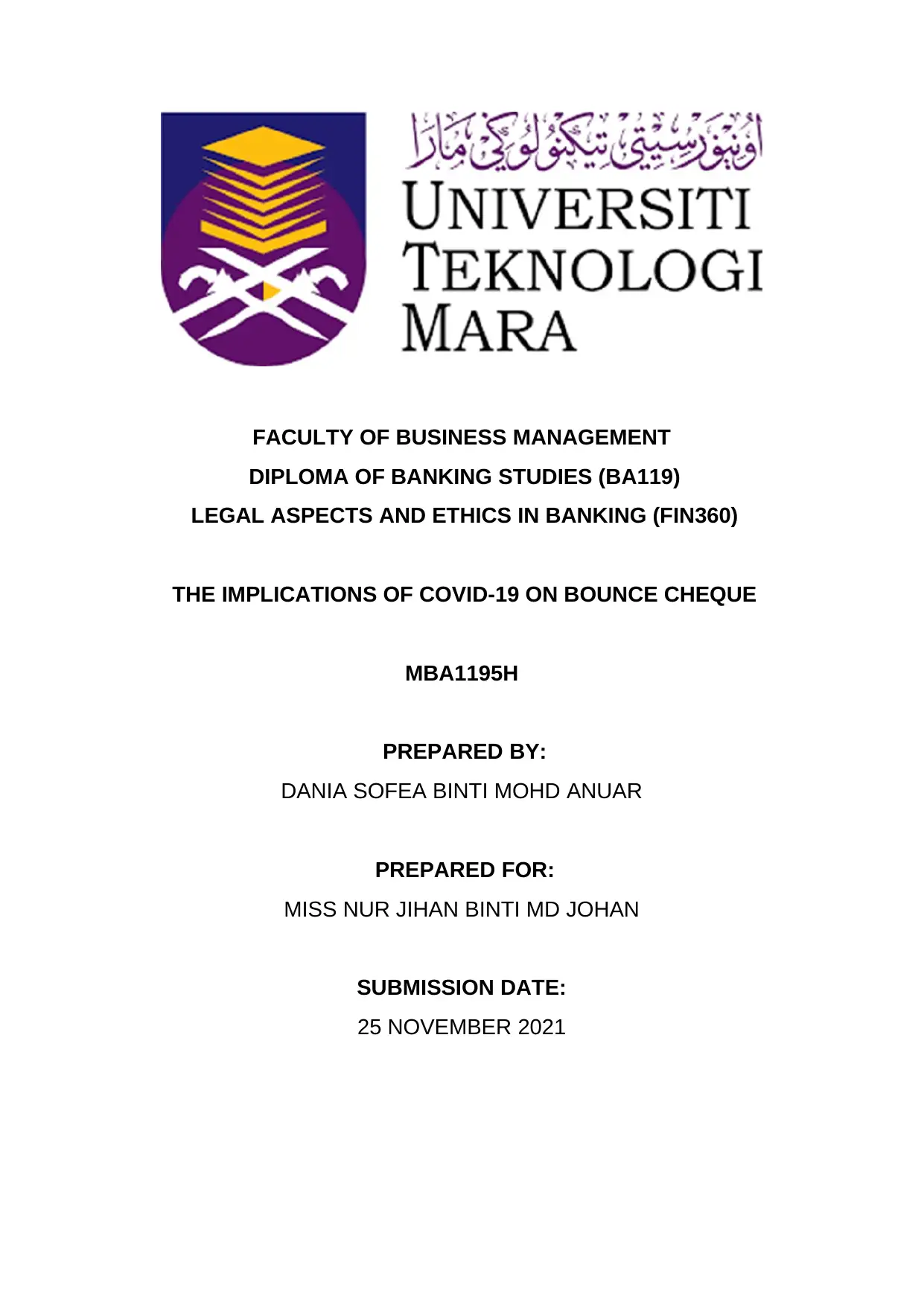
FACULTY OF BUSINESS MANAGEMENT
DIPLOMA OF BANKING STUDIES (BA119)
LEGAL ASPECTS AND ETHICS IN BANKING (FIN360)
THE IMPLICATIONS OF COVID-19 ON BOUNCE CHEQUE
MBA1195H
PREPARED BY:
DANIA SOFEA BINTI MOHD ANUAR
PREPARED FOR:
MISS NUR JIHAN BINTI MD JOHAN
SUBMISSION DATE:
25 NOVEMBER 2021
DIPLOMA OF BANKING STUDIES (BA119)
LEGAL ASPECTS AND ETHICS IN BANKING (FIN360)
THE IMPLICATIONS OF COVID-19 ON BOUNCE CHEQUE
MBA1195H
PREPARED BY:
DANIA SOFEA BINTI MOHD ANUAR
PREPARED FOR:
MISS NUR JIHAN BINTI MD JOHAN
SUBMISSION DATE:
25 NOVEMBER 2021
Secure Best Marks with AI Grader
Need help grading? Try our AI Grader for instant feedback on your assignments.
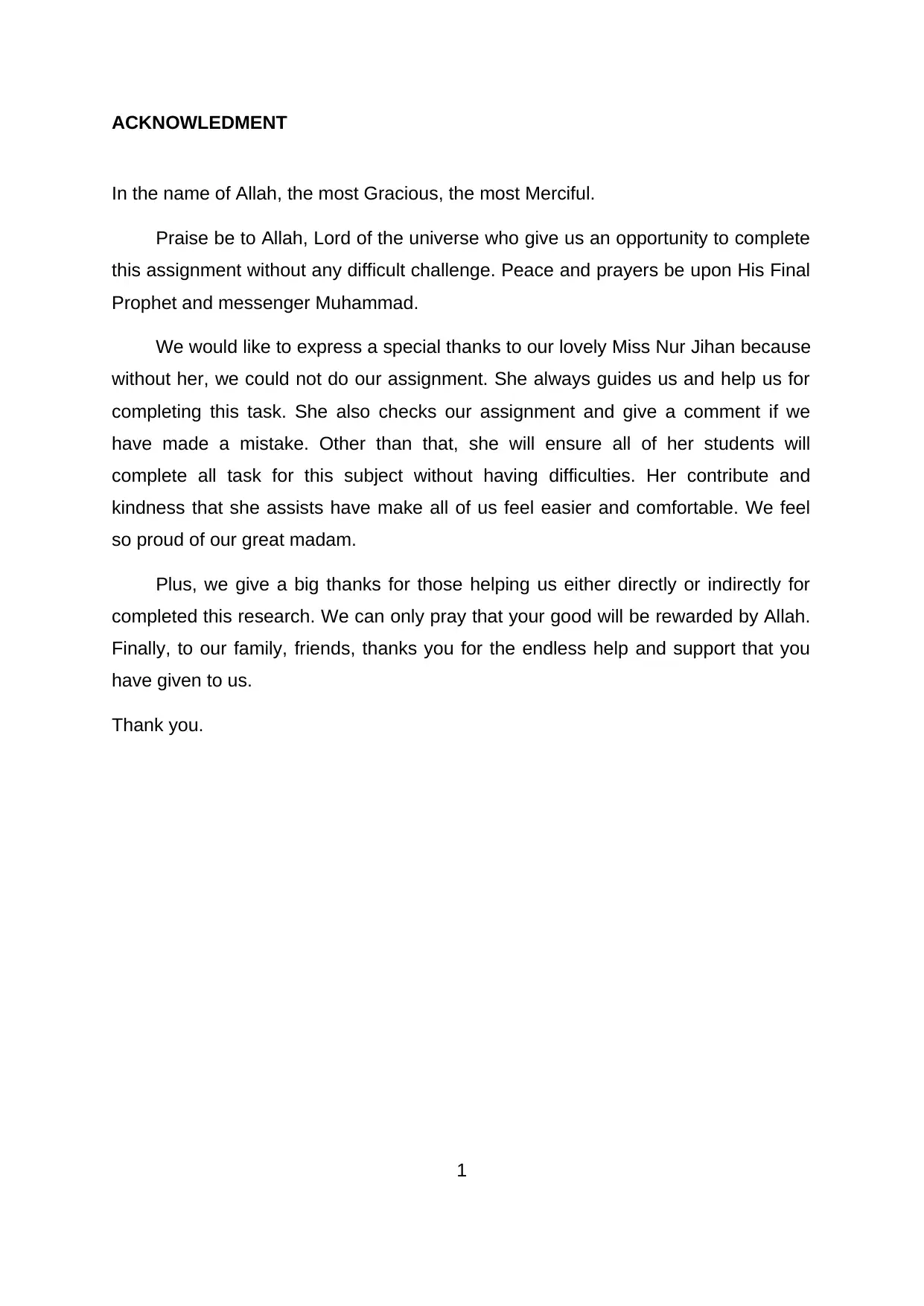
ACKNOWLEDMENT
In the name of Allah, the most Gracious, the most Merciful.
Praise be to Allah, Lord of the universe who give us an opportunity to complete
this assignment without any difficult challenge. Peace and prayers be upon His Final
Prophet and messenger Muhammad.
We would like to express a special thanks to our lovely Miss Nur Jihan because
without her, we could not do our assignment. She always guides us and help us for
completing this task. She also checks our assignment and give a comment if we
have made a mistake. Other than that, she will ensure all of her students will
complete all task for this subject without having difficulties. Her contribute and
kindness that she assists have make all of us feel easier and comfortable. We feel
so proud of our great madam.
Plus, we give a big thanks for those helping us either directly or indirectly for
completed this research. We can only pray that your good will be rewarded by Allah.
Finally, to our family, friends, thanks you for the endless help and support that you
have given to us.
Thank you.
1
In the name of Allah, the most Gracious, the most Merciful.
Praise be to Allah, Lord of the universe who give us an opportunity to complete
this assignment without any difficult challenge. Peace and prayers be upon His Final
Prophet and messenger Muhammad.
We would like to express a special thanks to our lovely Miss Nur Jihan because
without her, we could not do our assignment. She always guides us and help us for
completing this task. She also checks our assignment and give a comment if we
have made a mistake. Other than that, she will ensure all of her students will
complete all task for this subject without having difficulties. Her contribute and
kindness that she assists have make all of us feel easier and comfortable. We feel
so proud of our great madam.
Plus, we give a big thanks for those helping us either directly or indirectly for
completed this research. We can only pray that your good will be rewarded by Allah.
Finally, to our family, friends, thanks you for the endless help and support that you
have given to us.
Thank you.
1
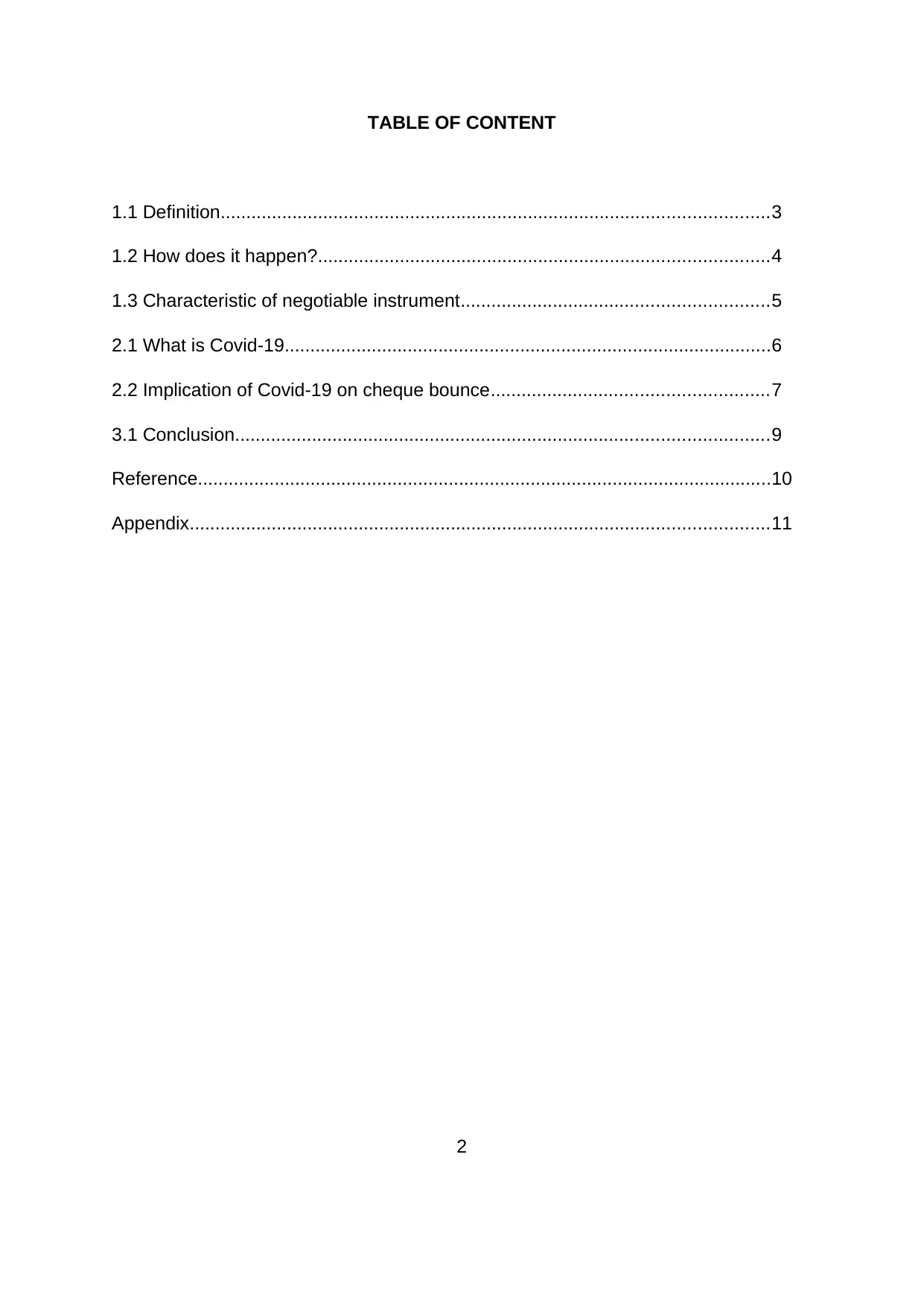
TABLE OF CONTENT
1.1 Definition...........................................................................................................3
1.2 How does it happen?........................................................................................4
1.3 Characteristic of negotiable instrument............................................................5
2.1 What is Covid-19...............................................................................................6
2.2 Implication of Covid-19 on cheque bounce......................................................7
3.1 Conclusion........................................................................................................9
Reference................................................................................................................10
Appendix.................................................................................................................11
2
1.1 Definition...........................................................................................................3
1.2 How does it happen?........................................................................................4
1.3 Characteristic of negotiable instrument............................................................5
2.1 What is Covid-19...............................................................................................6
2.2 Implication of Covid-19 on cheque bounce......................................................7
3.1 Conclusion........................................................................................................9
Reference................................................................................................................10
Appendix.................................................................................................................11
2
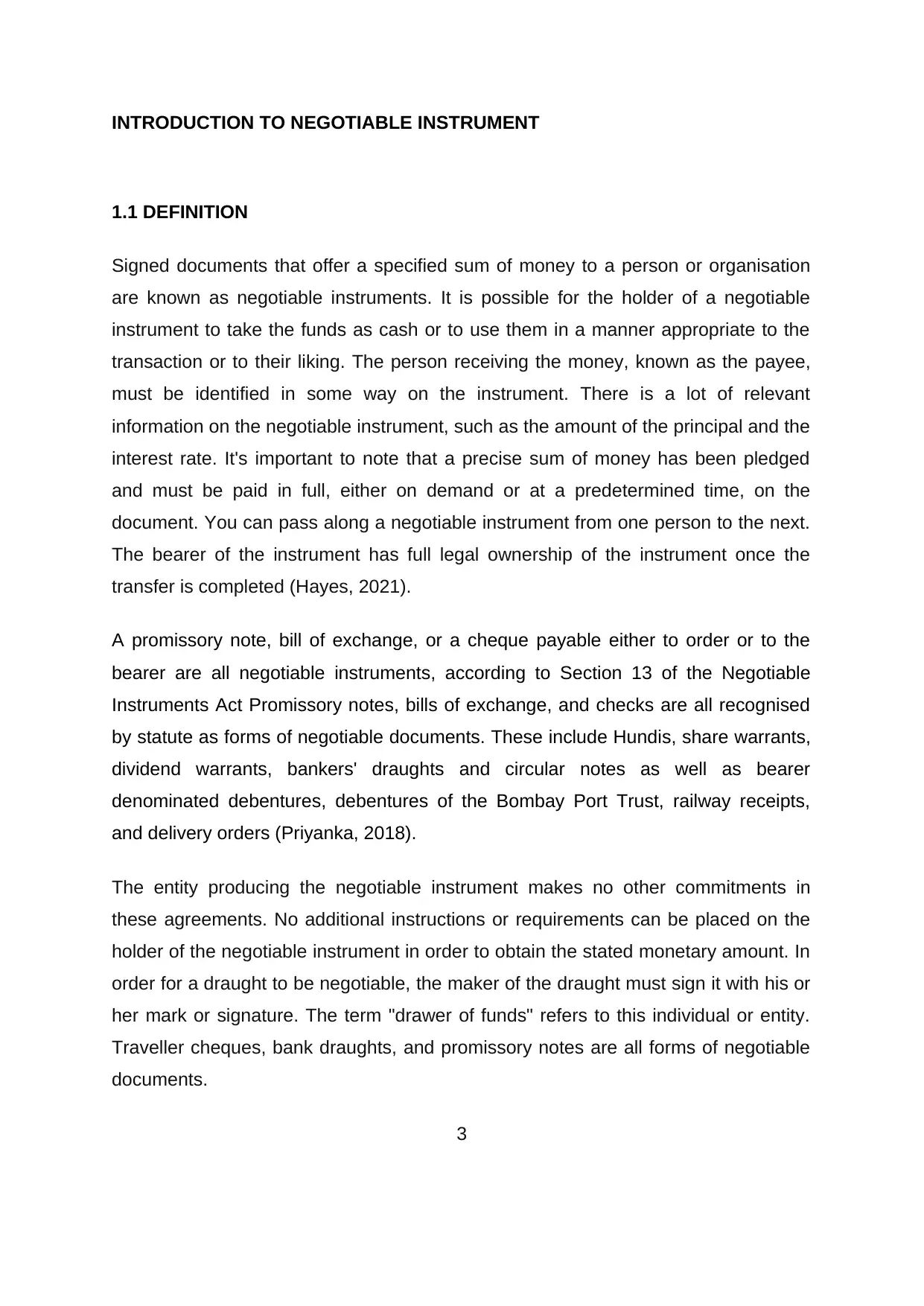
INTRODUCTION TO NEGOTIABLE INSTRUMENT
1.1 DEFINITION
Signed documents that offer a specified sum of money to a person or organisation
are known as negotiable instruments. It is possible for the holder of a negotiable
instrument to take the funds as cash or to use them in a manner appropriate to the
transaction or to their liking. The person receiving the money, known as the payee,
must be identified in some way on the instrument. There is a lot of relevant
information on the negotiable instrument, such as the amount of the principal and the
interest rate. It's important to note that a precise sum of money has been pledged
and must be paid in full, either on demand or at a predetermined time, on the
document. You can pass along a negotiable instrument from one person to the next.
The bearer of the instrument has full legal ownership of the instrument once the
transfer is completed (Hayes, 2021).
A promissory note, bill of exchange, or a cheque payable either to order or to the
bearer are all negotiable instruments, according to Section 13 of the Negotiable
Instruments Act Promissory notes, bills of exchange, and checks are all recognised
by statute as forms of negotiable documents. These include Hundis, share warrants,
dividend warrants, bankers' draughts and circular notes as well as bearer
denominated debentures, debentures of the Bombay Port Trust, railway receipts,
and delivery orders (Priyanka, 2018).
The entity producing the negotiable instrument makes no other commitments in
these agreements. No additional instructions or requirements can be placed on the
holder of the negotiable instrument in order to obtain the stated monetary amount. In
order for a draught to be negotiable, the maker of the draught must sign it with his or
her mark or signature. The term "drawer of funds" refers to this individual or entity.
Traveller cheques, bank draughts, and promissory notes are all forms of negotiable
documents.
3
1.1 DEFINITION
Signed documents that offer a specified sum of money to a person or organisation
are known as negotiable instruments. It is possible for the holder of a negotiable
instrument to take the funds as cash or to use them in a manner appropriate to the
transaction or to their liking. The person receiving the money, known as the payee,
must be identified in some way on the instrument. There is a lot of relevant
information on the negotiable instrument, such as the amount of the principal and the
interest rate. It's important to note that a precise sum of money has been pledged
and must be paid in full, either on demand or at a predetermined time, on the
document. You can pass along a negotiable instrument from one person to the next.
The bearer of the instrument has full legal ownership of the instrument once the
transfer is completed (Hayes, 2021).
A promissory note, bill of exchange, or a cheque payable either to order or to the
bearer are all negotiable instruments, according to Section 13 of the Negotiable
Instruments Act Promissory notes, bills of exchange, and checks are all recognised
by statute as forms of negotiable documents. These include Hundis, share warrants,
dividend warrants, bankers' draughts and circular notes as well as bearer
denominated debentures, debentures of the Bombay Port Trust, railway receipts,
and delivery orders (Priyanka, 2018).
The entity producing the negotiable instrument makes no other commitments in
these agreements. No additional instructions or requirements can be placed on the
holder of the negotiable instrument in order to obtain the stated monetary amount. In
order for a draught to be negotiable, the maker of the draught must sign it with his or
her mark or signature. The term "drawer of funds" refers to this individual or entity.
Traveller cheques, bank draughts, and promissory notes are all forms of negotiable
documents.
3
Secure Best Marks with AI Grader
Need help grading? Try our AI Grader for instant feedback on your assignments.
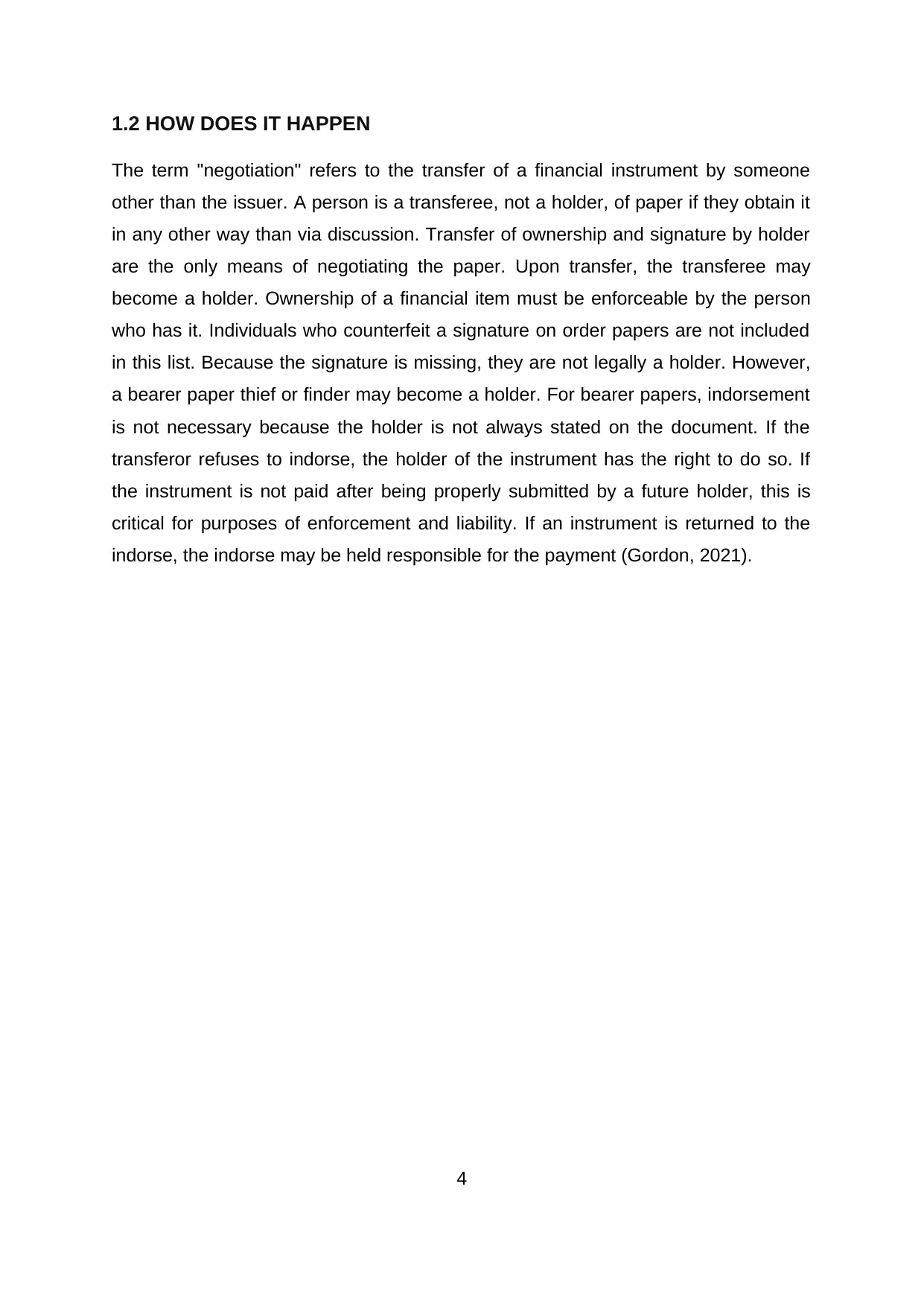
1.2 HOW DOES IT HAPPEN
The term "negotiation" refers to the transfer of a financial instrument by someone
other than the issuer. A person is a transferee, not a holder, of paper if they obtain it
in any other way than via discussion. Transfer of ownership and signature by holder
are the only means of negotiating the paper. Upon transfer, the transferee may
become a holder. Ownership of a financial item must be enforceable by the person
who has it. Individuals who counterfeit a signature on order papers are not included
in this list. Because the signature is missing, they are not legally a holder. However,
a bearer paper thief or finder may become a holder. For bearer papers, indorsement
is not necessary because the holder is not always stated on the document. If the
transferor refuses to indorse, the holder of the instrument has the right to do so. If
the instrument is not paid after being properly submitted by a future holder, this is
critical for purposes of enforcement and liability. If an instrument is returned to the
indorse, the indorse may be held responsible for the payment (Gordon, 2021).
4
The term "negotiation" refers to the transfer of a financial instrument by someone
other than the issuer. A person is a transferee, not a holder, of paper if they obtain it
in any other way than via discussion. Transfer of ownership and signature by holder
are the only means of negotiating the paper. Upon transfer, the transferee may
become a holder. Ownership of a financial item must be enforceable by the person
who has it. Individuals who counterfeit a signature on order papers are not included
in this list. Because the signature is missing, they are not legally a holder. However,
a bearer paper thief or finder may become a holder. For bearer papers, indorsement
is not necessary because the holder is not always stated on the document. If the
transferor refuses to indorse, the holder of the instrument has the right to do so. If
the instrument is not paid after being properly submitted by a future holder, this is
critical for purposes of enforcement and liability. If an instrument is returned to the
indorse, the indorse may be held responsible for the payment (Gordon, 2021).
4
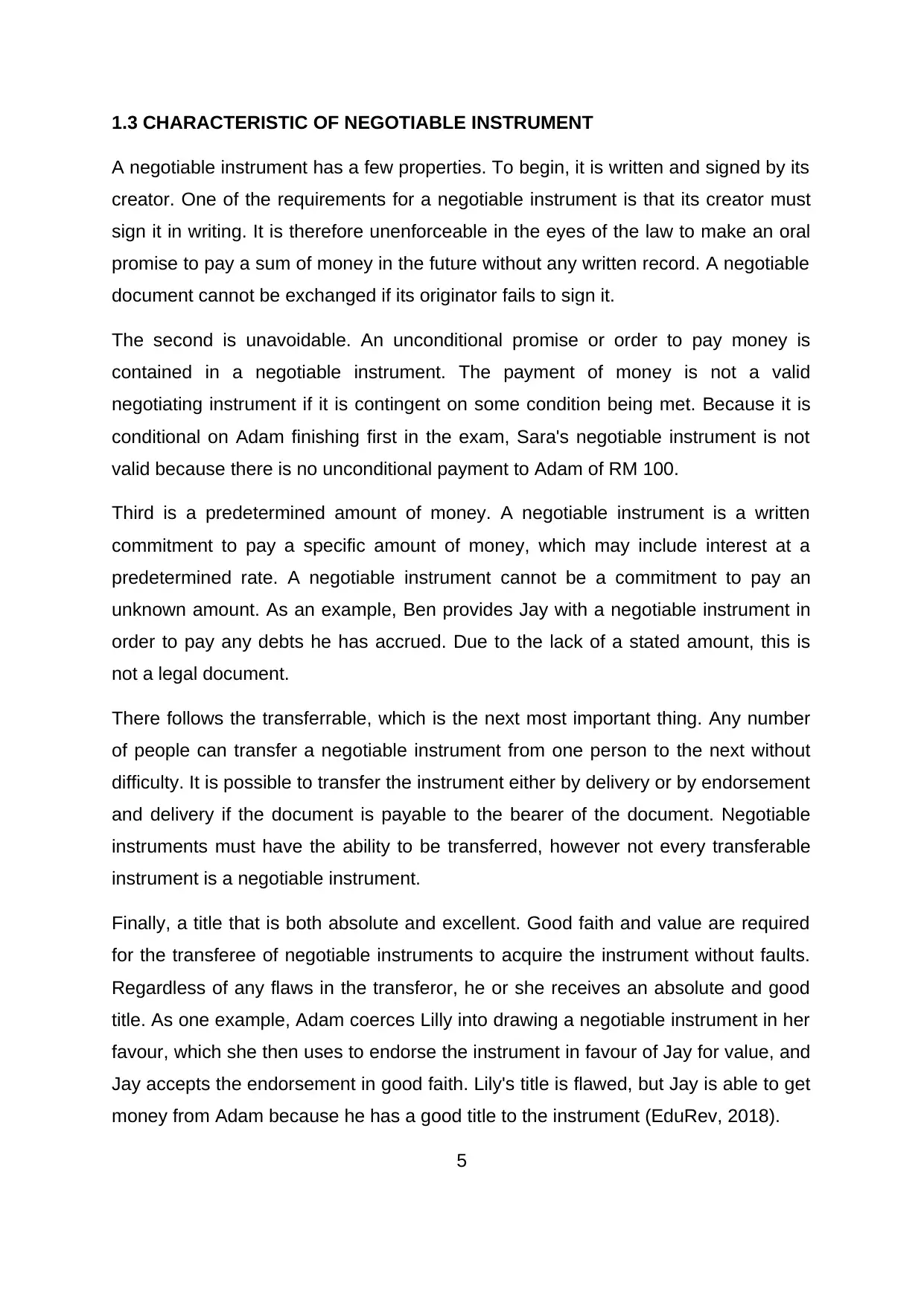
1.3 CHARACTERISTIC OF NEGOTIABLE INSTRUMENT
A negotiable instrument has a few properties. To begin, it is written and signed by its
creator. One of the requirements for a negotiable instrument is that its creator must
sign it in writing. It is therefore unenforceable in the eyes of the law to make an oral
promise to pay a sum of money in the future without any written record. A negotiable
document cannot be exchanged if its originator fails to sign it.
The second is unavoidable. An unconditional promise or order to pay money is
contained in a negotiable instrument. The payment of money is not a valid
negotiating instrument if it is contingent on some condition being met. Because it is
conditional on Adam finishing first in the exam, Sara's negotiable instrument is not
valid because there is no unconditional payment to Adam of RM 100.
Third is a predetermined amount of money. A negotiable instrument is a written
commitment to pay a specific amount of money, which may include interest at a
predetermined rate. A negotiable instrument cannot be a commitment to pay an
unknown amount. As an example, Ben provides Jay with a negotiable instrument in
order to pay any debts he has accrued. Due to the lack of a stated amount, this is
not a legal document.
There follows the transferrable, which is the next most important thing. Any number
of people can transfer a negotiable instrument from one person to the next without
difficulty. It is possible to transfer the instrument either by delivery or by endorsement
and delivery if the document is payable to the bearer of the document. Negotiable
instruments must have the ability to be transferred, however not every transferable
instrument is a negotiable instrument.
Finally, a title that is both absolute and excellent. Good faith and value are required
for the transferee of negotiable instruments to acquire the instrument without faults.
Regardless of any flaws in the transferor, he or she receives an absolute and good
title. As one example, Adam coerces Lilly into drawing a negotiable instrument in her
favour, which she then uses to endorse the instrument in favour of Jay for value, and
Jay accepts the endorsement in good faith. Lily's title is flawed, but Jay is able to get
money from Adam because he has a good title to the instrument (EduRev, 2018).
5
A negotiable instrument has a few properties. To begin, it is written and signed by its
creator. One of the requirements for a negotiable instrument is that its creator must
sign it in writing. It is therefore unenforceable in the eyes of the law to make an oral
promise to pay a sum of money in the future without any written record. A negotiable
document cannot be exchanged if its originator fails to sign it.
The second is unavoidable. An unconditional promise or order to pay money is
contained in a negotiable instrument. The payment of money is not a valid
negotiating instrument if it is contingent on some condition being met. Because it is
conditional on Adam finishing first in the exam, Sara's negotiable instrument is not
valid because there is no unconditional payment to Adam of RM 100.
Third is a predetermined amount of money. A negotiable instrument is a written
commitment to pay a specific amount of money, which may include interest at a
predetermined rate. A negotiable instrument cannot be a commitment to pay an
unknown amount. As an example, Ben provides Jay with a negotiable instrument in
order to pay any debts he has accrued. Due to the lack of a stated amount, this is
not a legal document.
There follows the transferrable, which is the next most important thing. Any number
of people can transfer a negotiable instrument from one person to the next without
difficulty. It is possible to transfer the instrument either by delivery or by endorsement
and delivery if the document is payable to the bearer of the document. Negotiable
instruments must have the ability to be transferred, however not every transferable
instrument is a negotiable instrument.
Finally, a title that is both absolute and excellent. Good faith and value are required
for the transferee of negotiable instruments to acquire the instrument without faults.
Regardless of any flaws in the transferor, he or she receives an absolute and good
title. As one example, Adam coerces Lilly into drawing a negotiable instrument in her
favour, which she then uses to endorse the instrument in favour of Jay for value, and
Jay accepts the endorsement in good faith. Lily's title is flawed, but Jay is able to get
money from Adam because he has a good title to the instrument (EduRev, 2018).
5
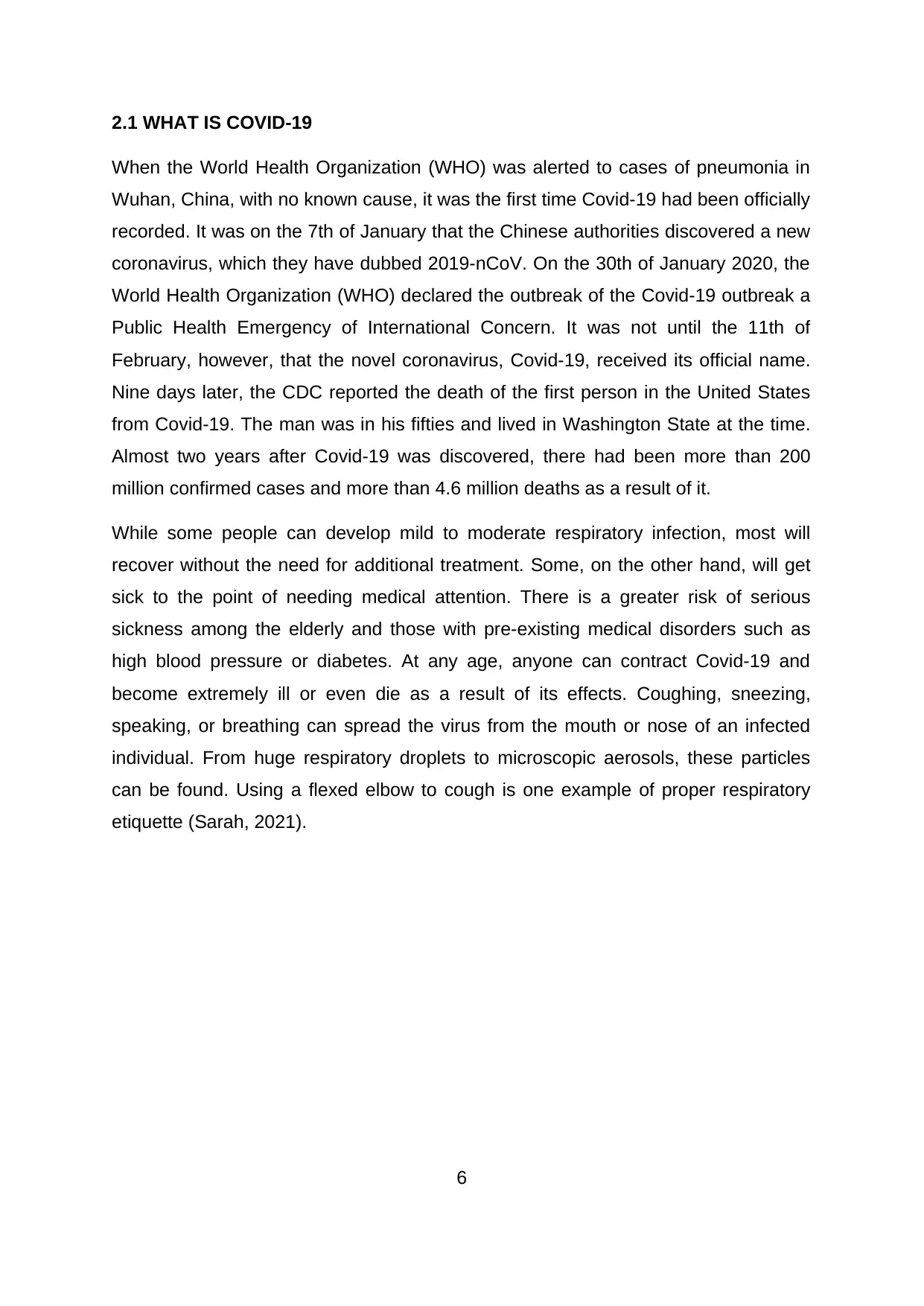
2.1 WHAT IS COVID-19
When the World Health Organization (WHO) was alerted to cases of pneumonia in
Wuhan, China, with no known cause, it was the first time Covid-19 had been officially
recorded. It was on the 7th of January that the Chinese authorities discovered a new
coronavirus, which they have dubbed 2019-nCoV. On the 30th of January 2020, the
World Health Organization (WHO) declared the outbreak of the Covid-19 outbreak a
Public Health Emergency of International Concern. It was not until the 11th of
February, however, that the novel coronavirus, Covid-19, received its official name.
Nine days later, the CDC reported the death of the first person in the United States
from Covid-19. The man was in his fifties and lived in Washington State at the time.
Almost two years after Covid-19 was discovered, there had been more than 200
million confirmed cases and more than 4.6 million deaths as a result of it.
While some people can develop mild to moderate respiratory infection, most will
recover without the need for additional treatment. Some, on the other hand, will get
sick to the point of needing medical attention. There is a greater risk of serious
sickness among the elderly and those with pre-existing medical disorders such as
high blood pressure or diabetes. At any age, anyone can contract Covid-19 and
become extremely ill or even die as a result of its effects. Coughing, sneezing,
speaking, or breathing can spread the virus from the mouth or nose of an infected
individual. From huge respiratory droplets to microscopic aerosols, these particles
can be found. Using a flexed elbow to cough is one example of proper respiratory
etiquette (Sarah, 2021).
6
When the World Health Organization (WHO) was alerted to cases of pneumonia in
Wuhan, China, with no known cause, it was the first time Covid-19 had been officially
recorded. It was on the 7th of January that the Chinese authorities discovered a new
coronavirus, which they have dubbed 2019-nCoV. On the 30th of January 2020, the
World Health Organization (WHO) declared the outbreak of the Covid-19 outbreak a
Public Health Emergency of International Concern. It was not until the 11th of
February, however, that the novel coronavirus, Covid-19, received its official name.
Nine days later, the CDC reported the death of the first person in the United States
from Covid-19. The man was in his fifties and lived in Washington State at the time.
Almost two years after Covid-19 was discovered, there had been more than 200
million confirmed cases and more than 4.6 million deaths as a result of it.
While some people can develop mild to moderate respiratory infection, most will
recover without the need for additional treatment. Some, on the other hand, will get
sick to the point of needing medical attention. There is a greater risk of serious
sickness among the elderly and those with pre-existing medical disorders such as
high blood pressure or diabetes. At any age, anyone can contract Covid-19 and
become extremely ill or even die as a result of its effects. Coughing, sneezing,
speaking, or breathing can spread the virus from the mouth or nose of an infected
individual. From huge respiratory droplets to microscopic aerosols, these particles
can be found. Using a flexed elbow to cough is one example of proper respiratory
etiquette (Sarah, 2021).
6
Paraphrase This Document
Need a fresh take? Get an instant paraphrase of this document with our AI Paraphraser
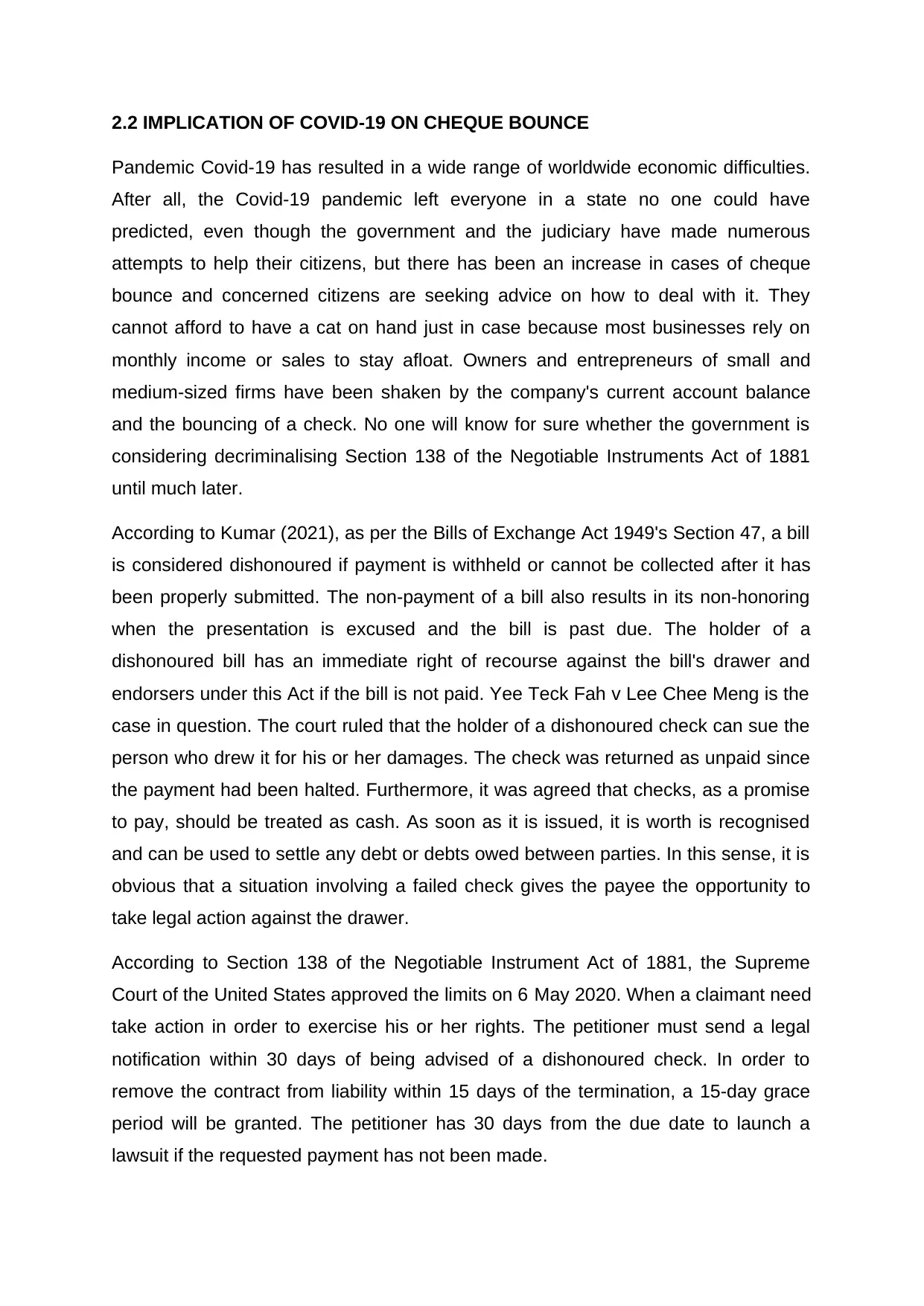
2.2 IMPLICATION OF COVID-19 ON CHEQUE BOUNCE
Pandemic Covid-19 has resulted in a wide range of worldwide economic difficulties.
After all, the Covid-19 pandemic left everyone in a state no one could have
predicted, even though the government and the judiciary have made numerous
attempts to help their citizens, but there has been an increase in cases of cheque
bounce and concerned citizens are seeking advice on how to deal with it. They
cannot afford to have a cat on hand just in case because most businesses rely on
monthly income or sales to stay afloat. Owners and entrepreneurs of small and
medium-sized firms have been shaken by the company's current account balance
and the bouncing of a check. No one will know for sure whether the government is
considering decriminalising Section 138 of the Negotiable Instruments Act of 1881
until much later.
According to Kumar (2021), as per the Bills of Exchange Act 1949's Section 47, a bill
is considered dishonoured if payment is withheld or cannot be collected after it has
been properly submitted. The non-payment of a bill also results in its non-honoring
when the presentation is excused and the bill is past due. The holder of a
dishonoured bill has an immediate right of recourse against the bill's drawer and
endorsers under this Act if the bill is not paid. Yee Teck Fah v Lee Chee Meng is the
case in question. The court ruled that the holder of a dishonoured check can sue the
person who drew it for his or her damages. The check was returned as unpaid since
the payment had been halted. Furthermore, it was agreed that checks, as a promise
to pay, should be treated as cash. As soon as it is issued, it is worth is recognised
and can be used to settle any debt or debts owed between parties. In this sense, it is
obvious that a situation involving a failed check gives the payee the opportunity to
take legal action against the drawer.
According to Section 138 of the Negotiable Instrument Act of 1881, the Supreme
Court of the United States approved the limits on 6 May 2020. When a claimant need
take action in order to exercise his or her rights. The petitioner must send a legal
notification within 30 days of being advised of a dishonoured check. In order to
remove the contract from liability within 15 days of the termination, a 15-day grace
period will be granted. The petitioner has 30 days from the due date to launch a
lawsuit if the requested payment has not been made.
Pandemic Covid-19 has resulted in a wide range of worldwide economic difficulties.
After all, the Covid-19 pandemic left everyone in a state no one could have
predicted, even though the government and the judiciary have made numerous
attempts to help their citizens, but there has been an increase in cases of cheque
bounce and concerned citizens are seeking advice on how to deal with it. They
cannot afford to have a cat on hand just in case because most businesses rely on
monthly income or sales to stay afloat. Owners and entrepreneurs of small and
medium-sized firms have been shaken by the company's current account balance
and the bouncing of a check. No one will know for sure whether the government is
considering decriminalising Section 138 of the Negotiable Instruments Act of 1881
until much later.
According to Kumar (2021), as per the Bills of Exchange Act 1949's Section 47, a bill
is considered dishonoured if payment is withheld or cannot be collected after it has
been properly submitted. The non-payment of a bill also results in its non-honoring
when the presentation is excused and the bill is past due. The holder of a
dishonoured bill has an immediate right of recourse against the bill's drawer and
endorsers under this Act if the bill is not paid. Yee Teck Fah v Lee Chee Meng is the
case in question. The court ruled that the holder of a dishonoured check can sue the
person who drew it for his or her damages. The check was returned as unpaid since
the payment had been halted. Furthermore, it was agreed that checks, as a promise
to pay, should be treated as cash. As soon as it is issued, it is worth is recognised
and can be used to settle any debt or debts owed between parties. In this sense, it is
obvious that a situation involving a failed check gives the payee the opportunity to
take legal action against the drawer.
According to Section 138 of the Negotiable Instrument Act of 1881, the Supreme
Court of the United States approved the limits on 6 May 2020. When a claimant need
take action in order to exercise his or her rights. The petitioner must send a legal
notification within 30 days of being advised of a dishonoured check. In order to
remove the contract from liability within 15 days of the termination, a 15-day grace
period will be granted. The petitioner has 30 days from the due date to launch a
lawsuit if the requested payment has not been made.
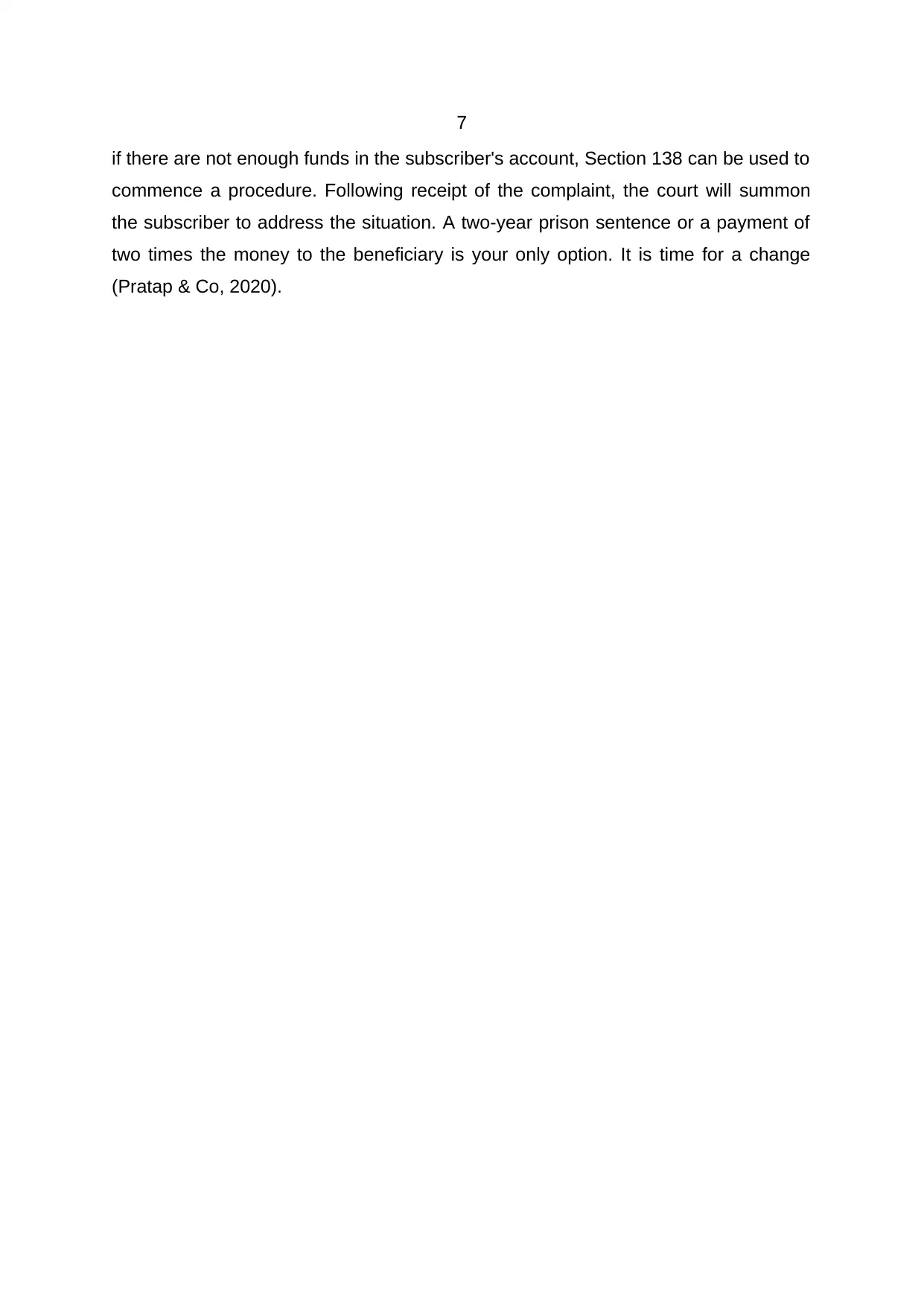
7
if there are not enough funds in the subscriber's account, Section 138 can be used to
commence a procedure. Following receipt of the complaint, the court will summon
the subscriber to address the situation. A two-year prison sentence or a payment of
two times the money to the beneficiary is your only option. It is time for a change
(Pratap & Co, 2020).
if there are not enough funds in the subscriber's account, Section 138 can be used to
commence a procedure. Following receipt of the complaint, the court will summon
the subscriber to address the situation. A two-year prison sentence or a payment of
two times the money to the beneficiary is your only option. It is time for a change
(Pratap & Co, 2020).
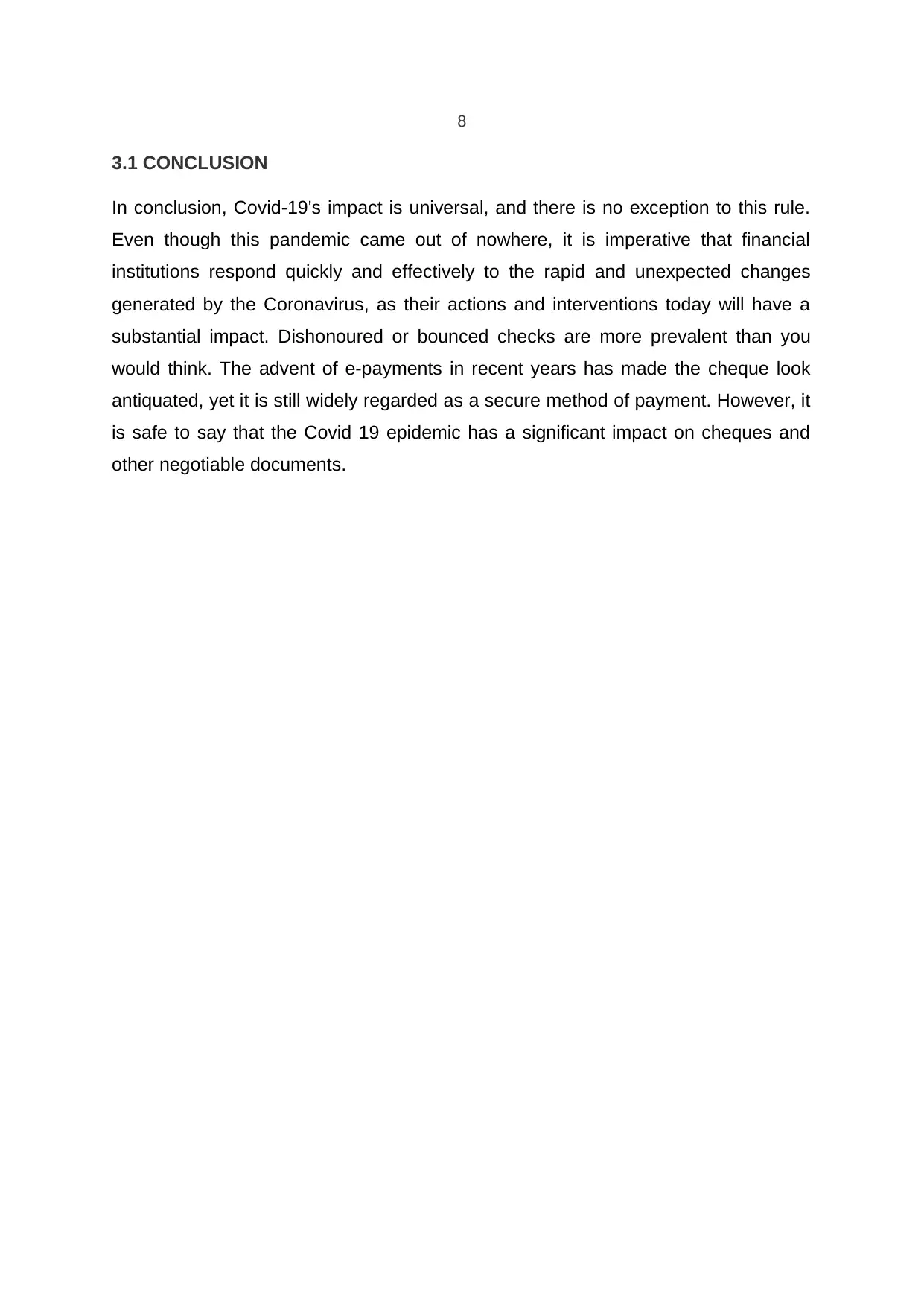
8
3.1 CONCLUSION
In conclusion, Covid-19's impact is universal, and there is no exception to this rule.
Even though this pandemic came out of nowhere, it is imperative that financial
institutions respond quickly and effectively to the rapid and unexpected changes
generated by the Coronavirus, as their actions and interventions today will have a
substantial impact. Dishonoured or bounced checks are more prevalent than you
would think. The advent of e-payments in recent years has made the cheque look
antiquated, yet it is still widely regarded as a secure method of payment. However, it
is safe to say that the Covid 19 epidemic has a significant impact on cheques and
other negotiable documents.
3.1 CONCLUSION
In conclusion, Covid-19's impact is universal, and there is no exception to this rule.
Even though this pandemic came out of nowhere, it is imperative that financial
institutions respond quickly and effectively to the rapid and unexpected changes
generated by the Coronavirus, as their actions and interventions today will have a
substantial impact. Dishonoured or bounced checks are more prevalent than you
would think. The advent of e-payments in recent years has made the cheque look
antiquated, yet it is still widely regarded as a secure method of payment. However, it
is safe to say that the Covid 19 epidemic has a significant impact on cheques and
other negotiable documents.
Secure Best Marks with AI Grader
Need help grading? Try our AI Grader for instant feedback on your assignments.
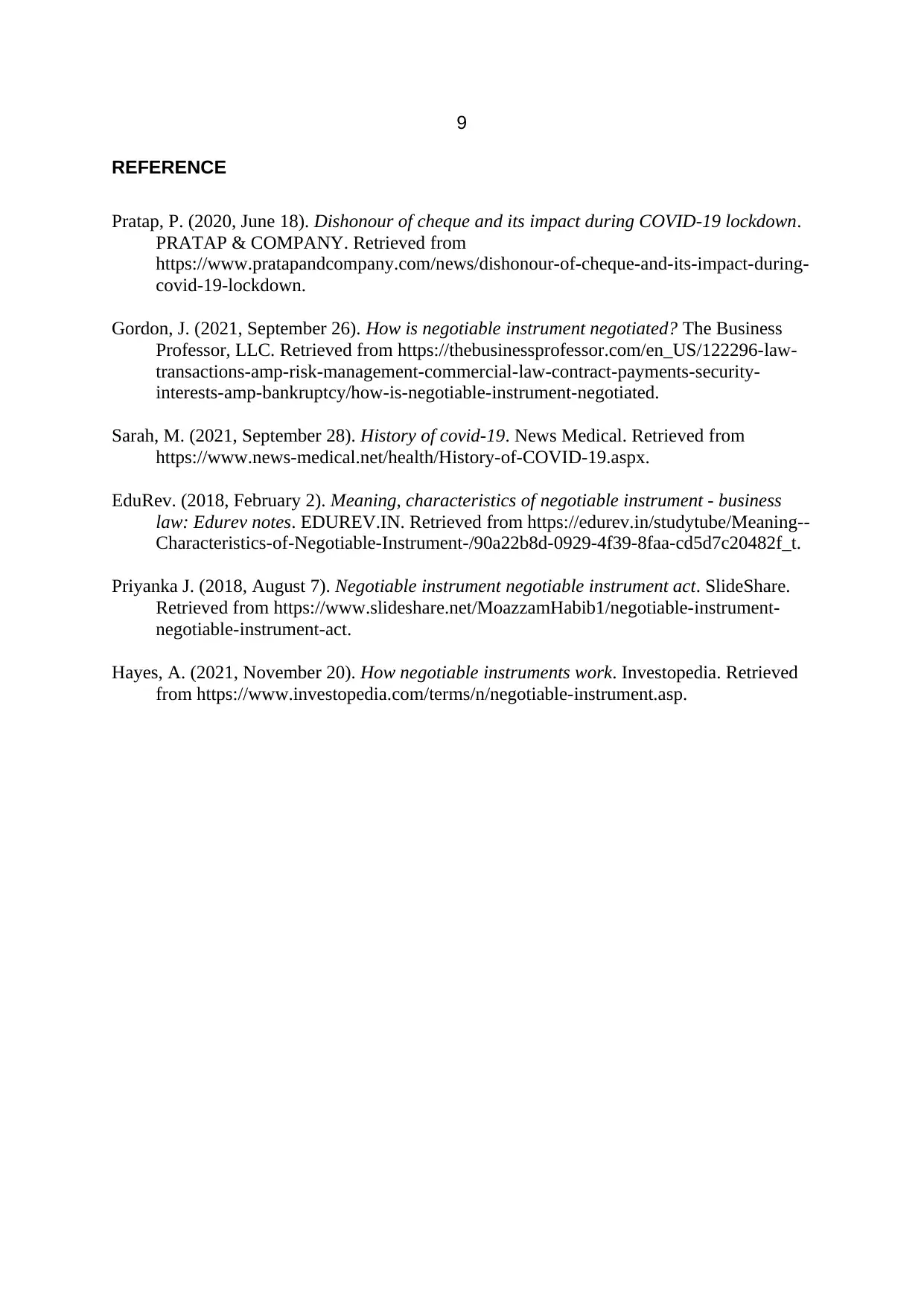
9
REFERENCE
Pratap, P. (2020, June 18). Dishonour of cheque and its impact during COVID-19 lockdown.
PRATAP & COMPANY. Retrieved from
https://www.pratapandcompany.com/news/dishonour-of-cheque-and-its-impact-during-
covid-19-lockdown.
Gordon, J. (2021, September 26). How is negotiable instrument negotiated? The Business
Professor, LLC. Retrieved from https://thebusinessprofessor.com/en_US/122296-law-
transactions-amp-risk-management-commercial-law-contract-payments-security-
interests-amp-bankruptcy/how-is-negotiable-instrument-negotiated.
Sarah, M. (2021, September 28). History of covid-19. News Medical. Retrieved from
https://www.news-medical.net/health/History-of-COVID-19.aspx.
EduRev. (2018, February 2). Meaning, characteristics of negotiable instrument - business
law: Edurev notes. EDUREV.IN. Retrieved from https://edurev.in/studytube/Meaning--
Characteristics-of-Negotiable-Instrument-/90a22b8d-0929-4f39-8faa-cd5d7c20482f_t.
Priyanka J. (2018, August 7). Negotiable instrument negotiable instrument act. SlideShare.
Retrieved from https://www.slideshare.net/MoazzamHabib1/negotiable-instrument-
negotiable-instrument-act.
Hayes, A. (2021, November 20). How negotiable instruments work. Investopedia. Retrieved
from https://www.investopedia.com/terms/n/negotiable-instrument.asp.
REFERENCE
Pratap, P. (2020, June 18). Dishonour of cheque and its impact during COVID-19 lockdown.
PRATAP & COMPANY. Retrieved from
https://www.pratapandcompany.com/news/dishonour-of-cheque-and-its-impact-during-
covid-19-lockdown.
Gordon, J. (2021, September 26). How is negotiable instrument negotiated? The Business
Professor, LLC. Retrieved from https://thebusinessprofessor.com/en_US/122296-law-
transactions-amp-risk-management-commercial-law-contract-payments-security-
interests-amp-bankruptcy/how-is-negotiable-instrument-negotiated.
Sarah, M. (2021, September 28). History of covid-19. News Medical. Retrieved from
https://www.news-medical.net/health/History-of-COVID-19.aspx.
EduRev. (2018, February 2). Meaning, characteristics of negotiable instrument - business
law: Edurev notes. EDUREV.IN. Retrieved from https://edurev.in/studytube/Meaning--
Characteristics-of-Negotiable-Instrument-/90a22b8d-0929-4f39-8faa-cd5d7c20482f_t.
Priyanka J. (2018, August 7). Negotiable instrument negotiable instrument act. SlideShare.
Retrieved from https://www.slideshare.net/MoazzamHabib1/negotiable-instrument-
negotiable-instrument-act.
Hayes, A. (2021, November 20). How negotiable instruments work. Investopedia. Retrieved
from https://www.investopedia.com/terms/n/negotiable-instrument.asp.
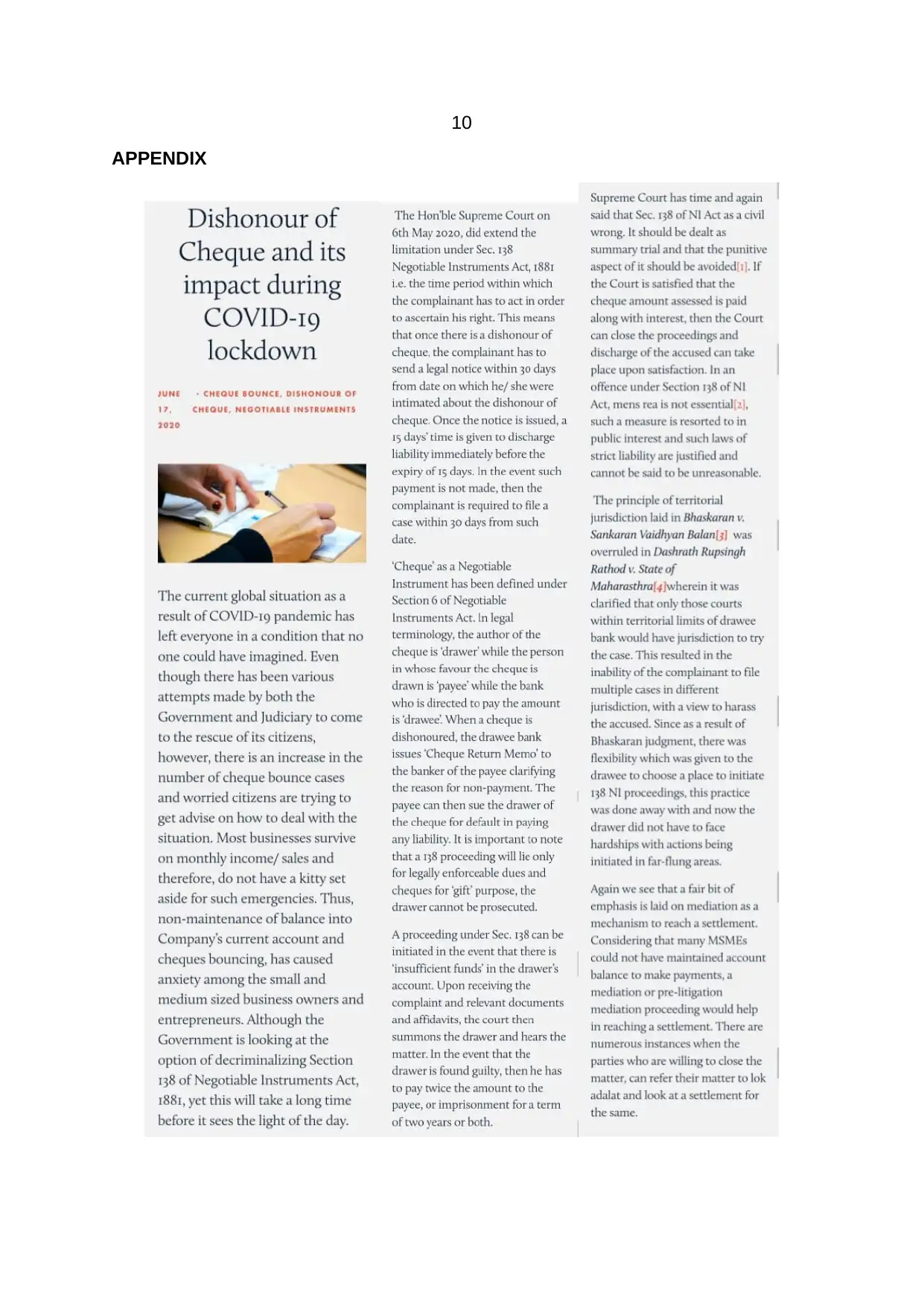
10
APPENDIX
APPENDIX

11
1 out of 13
Your All-in-One AI-Powered Toolkit for Academic Success.
+13062052269
info@desklib.com
Available 24*7 on WhatsApp / Email
![[object Object]](/_next/static/media/star-bottom.7253800d.svg)
Unlock your academic potential
© 2024 | Zucol Services PVT LTD | All rights reserved.
